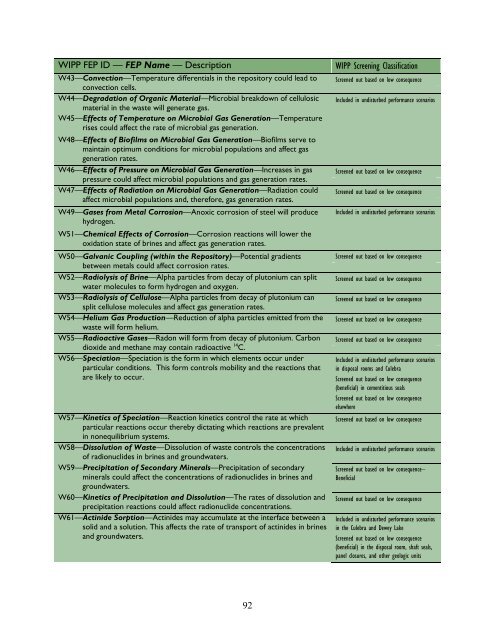Salt Disposal of Heat-Generating Nuclear Waste
Salt Disposal of Heat-Generating Nuclear Waste
Salt Disposal of Heat-Generating Nuclear Waste
Create successful ePaper yourself
Turn your PDF publications into a flip-book with our unique Google optimized e-Paper software.
WIPP FEP ID — FEP Name — Description<br />
W43—Convection—Temperature differentials in the repository could lead to<br />
convection cells.<br />
W44—Degradation <strong>of</strong> Organic Material—Microbial breakdown <strong>of</strong> cellulosic<br />
material in the waste will generate gas.<br />
W45—Effects <strong>of</strong> Temperature on Microbial Gas Generation—Temperature<br />
rises could affect the rate <strong>of</strong> microbial gas generation.<br />
W48—Effects <strong>of</strong> Bi<strong>of</strong>ilms on Microbial Gas Generation—Bi<strong>of</strong>ilms serve to<br />
maintain optimum conditions for microbial populations and affect gas<br />
generation rates.<br />
W46—Effects <strong>of</strong> Pressure on Microbial Gas Generation—Increases in gas<br />
pressure could affect microbial populations and gas generation rates.<br />
W47—Effects <strong>of</strong> Radiation on Microbial Gas Generation—Radiation could<br />
affect microbial populations and, therefore, gas generation rates.<br />
W49—Gases from Metal Corrosion—Anoxic corrosion <strong>of</strong> steel will produce<br />
hydrogen.<br />
W51—Chemical Effects <strong>of</strong> Corrosion—Corrosion reactions will lower the<br />
oxidation state <strong>of</strong> brines and affect gas generation rates.<br />
W50—Galvanic Coupling (within the Repository)—Potential gradients<br />
between metals could affect corrosion rates.<br />
W52—Radiolysis <strong>of</strong> Brine—Alpha particles from decay <strong>of</strong> plutonium can split<br />
water molecules to form hydrogen and oxygen.<br />
W53—Radiolysis <strong>of</strong> Cellulose—Alpha particles from decay <strong>of</strong> plutonium can<br />
split cellulose molecules and affect gas generation rates.<br />
W54—Helium Gas Production—Reduction <strong>of</strong> alpha particles emitted from the<br />
waste will form helium.<br />
W55—Radioactive Gases—Radon will form from decay <strong>of</strong> plutonium. Carbon<br />
dioxide and methane may contain radioactive 14 C.<br />
W56—Speciation—Speciation is the form in which elements occur under<br />
particular conditions. This form controls mobility and the reactions that<br />
are likely to occur.<br />
W57—Kinetics <strong>of</strong> Speciation—Reaction kinetics control the rate at which<br />
particular reactions occur thereby dictating which reactions are prevalent<br />
in nonequilibrium systems.<br />
W58—Dissolution <strong>of</strong> <strong>Waste</strong>—Dissolution <strong>of</strong> waste controls the concentrations<br />
<strong>of</strong> radionuclides in brines and groundwaters.<br />
W59—Precipitation <strong>of</strong> Secondary Minerals—Precipitation <strong>of</strong> secondary<br />
minerals could affect the concentrations <strong>of</strong> radionuclides in brines and<br />
groundwaters.<br />
W60—Kinetics <strong>of</strong> Precipitation and Dissolution—The rates <strong>of</strong> dissolution and<br />
precipitation reactions could affect radionuclide concentrations.<br />
W61—Actinide Sorption—Actinides may accumulate at the interface between a<br />
solid and a solution. This affects the rate <strong>of</strong> transport <strong>of</strong> actinides in brines<br />
and groundwaters.<br />
WIPP Screening Classification<br />
Screened out based on low consequence<br />
Included in undisturbed performance scenarios<br />
Screened out based on low consequence<br />
Screened out based on low consequence<br />
Included in undisturbed performance scenarios<br />
Screened out based on low consequence<br />
Screened out based on low consequence<br />
Screened out based on low consequence<br />
Screened out based on low consequence<br />
Screened out based on low consequence<br />
Included in undisturbed performance scenarios<br />
in disposal rooms and Culebra<br />
Screened out based on low consequence<br />
(beneficial) in cementitious seals<br />
Screened out based on low consequence<br />
elsewhere<br />
Screened out based on low consequence<br />
Included in undisturbed performance scenarios<br />
Screened out based on low consequence–<br />
Beneficial<br />
Screened out based on low consequence<br />
Included in undisturbed performance scenarios<br />
in the Culebra and Dewey Lake<br />
Screened out based on low consequence<br />
(beneficial) in the disposal room, shaft seals,<br />
panel closures, and other geologic units<br />
92
















